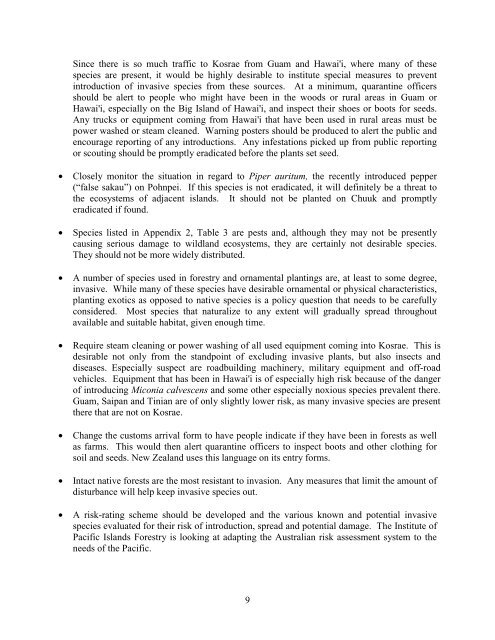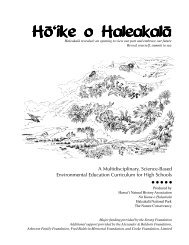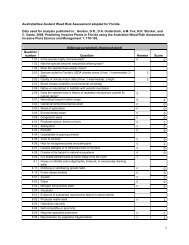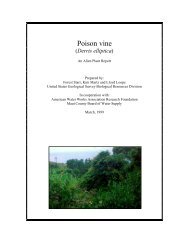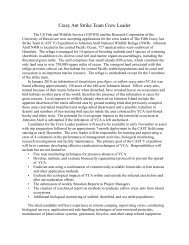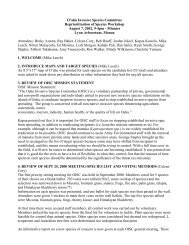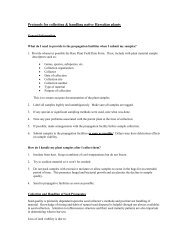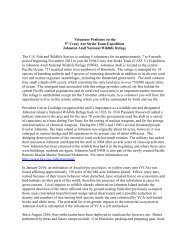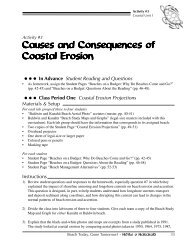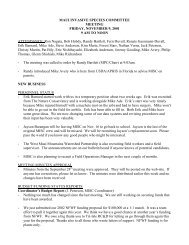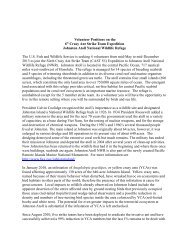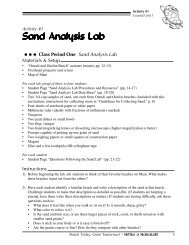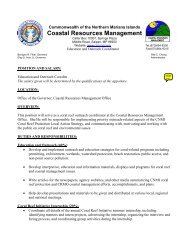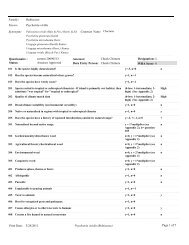Invasive plant species on Kosrae, Federated States of Micronesia
Invasive plant species on Kosrae, Federated States of Micronesia
Invasive plant species on Kosrae, Federated States of Micronesia
You also want an ePaper? Increase the reach of your titles
YUMPU automatically turns print PDFs into web optimized ePapers that Google loves.
Since there is so much traffic to <strong>Kosrae</strong> from Guam and Hawai'i, where many <strong>of</strong> these<br />
<str<strong>on</strong>g>species</str<strong>on</strong>g> are present, it would be highly desirable to institute special measures to prevent<br />
introducti<strong>on</strong> <strong>of</strong> invasive <str<strong>on</strong>g>species</str<strong>on</strong>g> from these sources. At a minimum, quarantine <strong>of</strong>ficers<br />
should be alert to people who might have been in the woods or rural areas in Guam or<br />
Hawai'i, especially <strong>on</strong> the Big Island <strong>of</strong> Hawai'i, and inspect their shoes or boots for seeds.<br />
Any trucks or equipment coming from Hawai'i that have been used in rural areas must be<br />
power washed or steam cleaned. Warning posters should be produced to alert the public and<br />
encourage reporting <strong>of</strong> any introducti<strong>on</strong>s. Any infestati<strong>on</strong>s picked up from public reporting<br />
or scouting should be promptly eradicated before the <str<strong>on</strong>g>plant</str<strong>on</strong>g>s set seed.<br />
• Closely m<strong>on</strong>itor the situati<strong>on</strong> in regard to Piper auritum, the recently introduced pepper<br />
(“false sakau”) <strong>on</strong> Pohnpei. If this <str<strong>on</strong>g>species</str<strong>on</strong>g> is not eradicated, it will definitely be a threat to<br />
the ecosystems <strong>of</strong> adjacent islands. It should not be <str<strong>on</strong>g>plant</str<strong>on</strong>g>ed <strong>on</strong> Chuuk and promptly<br />
eradicated if found.<br />
• Species listed in Appendix 2, Table 3 are pests and, although they may not be presently<br />
causing serious damage to wildland ecosystems, they are certainly not desirable <str<strong>on</strong>g>species</str<strong>on</strong>g>.<br />
They should not be more widely distributed.<br />
• A number <strong>of</strong> <str<strong>on</strong>g>species</str<strong>on</strong>g> used in forestry and ornamental <str<strong>on</strong>g>plant</str<strong>on</strong>g>ings are, at least to some degree,<br />
invasive. While many <strong>of</strong> these <str<strong>on</strong>g>species</str<strong>on</strong>g> have desirable ornamental or physical characteristics,<br />
<str<strong>on</strong>g>plant</str<strong>on</strong>g>ing exotics as opposed to native <str<strong>on</strong>g>species</str<strong>on</strong>g> is a policy questi<strong>on</strong> that needs to be carefully<br />
c<strong>on</strong>sidered. Most <str<strong>on</strong>g>species</str<strong>on</strong>g> that naturalize to any extent will gradually spread throughout<br />
available and suitable habitat, given enough time.<br />
• Require steam cleaning or power washing <strong>of</strong> all used equipment coming into <strong>Kosrae</strong>. This is<br />
desirable not <strong>on</strong>ly from the standpoint <strong>of</strong> excluding invasive <str<strong>on</strong>g>plant</str<strong>on</strong>g>s, but also insects and<br />
diseases. Especially suspect are roadbuilding machinery, military equipment and <strong>of</strong>f-road<br />
vehicles. Equipment that has been in Hawai'i is <strong>of</strong> especially high risk because <strong>of</strong> the danger<br />
<strong>of</strong> introducing Mic<strong>on</strong>ia calvescens and some other especially noxious <str<strong>on</strong>g>species</str<strong>on</strong>g> prevalent there.<br />
Guam, Saipan and Tinian are <strong>of</strong> <strong>on</strong>ly slightly lower risk, as many invasive <str<strong>on</strong>g>species</str<strong>on</strong>g> are present<br />
there that are not <strong>on</strong> <strong>Kosrae</strong>.<br />
• Change the customs arrival form to have people indicate if they have been in forests as well<br />
as farms. This would then alert quarantine <strong>of</strong>ficers to inspect boots and other clothing for<br />
soil and seeds. New Zealand uses this language <strong>on</strong> its entry forms.<br />
• Intact native forests are the most resistant to invasi<strong>on</strong>. Any measures that limit the amount <strong>of</strong><br />
disturbance will help keep invasive <str<strong>on</strong>g>species</str<strong>on</strong>g> out.<br />
• A risk-rating scheme should be developed and the various known and potential invasive<br />
<str<strong>on</strong>g>species</str<strong>on</strong>g> evaluated for their risk <strong>of</strong> introducti<strong>on</strong>, spread and potential damage. The Institute <strong>of</strong><br />
Pacific Islands Forestry is looking at adapting the Australian risk assessment system to the<br />
needs <strong>of</strong> the Pacific.<br />
9


